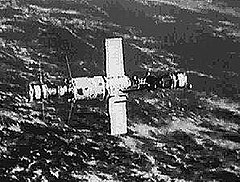Salyut 6

Salyut 6 with docked Soyuz and Progress spacecraft.
|
|

Salyut programme insignia.
|
|
| Station statistics | |
|---|---|
| Call sign | Salyut 6 |
| Crew | 3 |
| Launch | 29 September 1977 06:50:00 UTC |
| Launch pad | LC-81/24, Baikonur Cosmodrome, Soviet Union |
| Reentry | 29 July 1982 |
| Mass | 19,824 kilograms |
| Length | 15.8 metres |
| Diameter | 4.15 metres |
| Pressurised volume | 90 metres³ |
| Perigee | 219 kilometres (136 mi) |
| Apogee | 275 kilometres (171 mi) |
| Orbital inclination | 51.6 degrees |
| Orbital period | 89.1 minutes |
| Orbits per day | 16.16 |
| Days in orbit | 1,764 days |
| Days occupied | 683 days |
| No. of orbits | 28,024 |
| Distance travelled | ~1,136,861,930 km (~706,413,253 mi) |
| Statistics as of deorbit on 29 July 1982 References: |
|
| Configuration | |

Basic orbital configuration of Salyut 6
|
|
Salyut 6 (Russian: Салют-6; lit. Salute 6), DOS-5, was a Soviet orbital space station, the eighth flown as part of the Salyut programme. Launched on 29 September 1977 by a Proton rocket, the station was the first of the 'second-generation' type of space station. Salyut 6 possessed several revolutionary advances over the earlier Soviet space stations, which it nevertheless resembled in overall design. These included the addition of a second docking port, a new main propulsion system and the station's primary scientific instrument, the BST-1M multispectral telescope. The addition of the second docking port made crew handovers and station resupply by unmanned Progress freighters possible for the first time. The early Salyut stations had no means of resupply or removing accumulated garbage (aside from the limited amount that cosmonauts could carry in their Soyuz spacecraft), nor could the propulsion system be refueled once it exhausted its propellant supply. Consequently, once the consumables launched with the station were used up, its mission had to be concluded and as a result, manned missions had a maximum duration of three months. Progress spacecraft could now bring fresh supplies and propellant and also be used to dispose of waste, which was then destroyed once the spacecraft was deorbited.
Five crew residencies took place over the station's lifespan, in late 1977-early 1978, late 1978, mid-1979, mid-1980, and early 1981, including cosmonauts from Warsaw Pact countries as part of the Intercosmos programme. These crews were responsible for carrying out the primary missions of Salyut 6, including astronomy, Earth-resources observations and the study of the effect of spaceflight on the human body. Following the completion of these missions and the launch of its successor, Salyut 7, Salyut 6 was deorbited on 29 July 1982, almost five years after its launch.
Salyut 6, launched on a Proton 8K82K rocket on 29 September 1977, marked the switch from engineering development stations to routine operations, and united the most effective elements from each of the previous stations. Its navigation system, made up of the Delta semi-automatic computer to depict the station's orbit and the Kaskad system to control its orientation, was based on that used on Salyut 4, as was its power system, which consisted of a trio of steerable solar panels together producing a peak of 4 kilowatts of power over 51 m². The station's thermal regulation systems, which made use of a sophisticated arrangement of insulation and radiators, was also derived from that used on Salyut 4. In addition, Salyut 6 made use of environmental systems first used on Salyut 3, and controlled its orientation using gyrodynes first tested on that station.
...
Wikipedia
